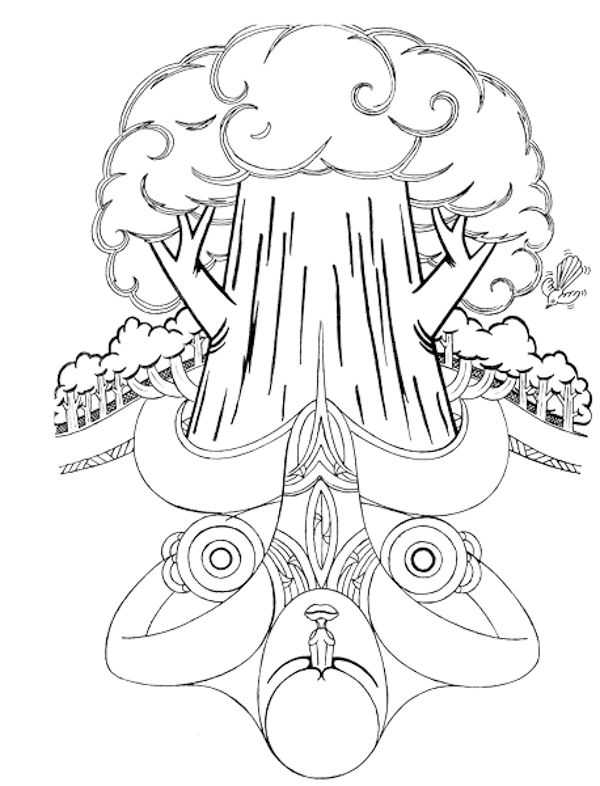
Tānemahuta – Atua associated with the forest and all that dwells in it. Qualities of growth, strength, shelter, diversity of life.
Where have we come from and what do we know now?
Some animals, like ferrets, stoats and weasels (known as mustelids), were introduced to our land in the 1870s and 1880s to control rabbit plagues causing serious pastoral damage on farms. Unfortunately, when they reached our lush shores, they bypassed the farms and instead headed straight for the bush where they began feasting on our native birds and their eggs.
In order to control the happily flourishing rabbits, cats were brought here and they, too, headed for the bush and enjoyed a banquet of native birds, lizards and large insects. The combined efforts of these predators wiped out entire populations of native birds. Meanwhile the rabbit populations spiralled out of control.
Other animals, like possums, were brought here from Australia in the 1830s to form the basis of a fur industry. Once they made themselves at home, they spread rapidly, and we now have millions of them chomping away at our forests and the native animals and birds that rightfully belong there.
Many of these creatures did not cause problems in their home countries where they belonged. In their native Australia, for example, possums are a protected species and it is illegal to kill or catch and release them without a licence.
The introduced animals just happen to have the misfortune to be among those brought to New Zealand to fix situations that became far worse than the problems they were brought here to solve.
There are other introduced animals in our country, including rats that came with early sailors, red deer brought here to provide sportsmen with game, goats that escaped into the bush, and wild pigs introduced in the late 1700s by early explorers.
But it’s the control of possums that is the focus of this story because it’s an inspiring tale involving communities across the land, school students in the Enviroschools Programme, hardworking trappers who understand the ethical side of their work, and a burgeoning industry based on fur.
Finally, the possum is no longer just a pest, it is the basis of an industry first envisaged when it was introduced to New Zealand almost 200 years ago.
Legislation
Now that we’ve established it’s not the introduced animals’ fault that they’re causing such a problem in our country, we need to make sure we treat the predators with respect in our efforts to get rid of them. They’re just creatures doing what they naturally do, when all’s said and done. Their only “crime” is that they’re in the wrong place, at the wrong time and for the wrong purpose.
We must treat them with respect, follow the rules regarding the use of live and kill traps, and end their lives as humanely as possible. There’s strict legislation regarding the welfare performance of live animal and kill traps and there are rules about the types of traps that can be used, how they must be used to cause minimal pain and suffering to the trapped animal, and how to dispose of the animals safely.
In New Zealand, trap use is regulated by the Animal Welfare Act 1999 and enacted through a National Welfare Advisory Committee (NAWAC). This committee assesses the welfare performance of traps. Some traps, like the old leg-hold gin traps, are illegal. There are trap testing guidelines for other traps, which must be operated in accordance with NAWAC kill trap testing specifications.
The testing of traps and identification of traps that perform poorly will, over time, ensure the welfare of trapped animals in New Zealand continually improves. The welfare of animals does not depend solely on the traps, but also on the way they are used, for example how they are baited and where and how they are set.
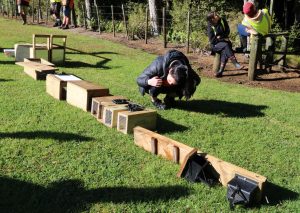
There’s more than one way to trap a pest, as this line-up of devices shows.
Exploring alternatives and taking action through the Enviroschools Project Pest Control Programme
The Northland Enviroschools Project Pest Control Programme is a huge success, opening-up real opportunities for students including educational qualifications (NCEA credits), career pathways and the very real potential to make a living from possum fur.
The programme started with Project Possum in 2011 and evolved to include Project Mustelid in 2016 and Project Rodent in 2017. The three initiatives were combined into Project Pest Control the following year and now enjoy considerable success in the battle against pests. Northland Regional Council (NRC) and Can Train NZ tutors run the theory and in-field based programme, teaching students to respect animal pests and showing them how to trap and kill them humanely, skin possums or pluck their fur.
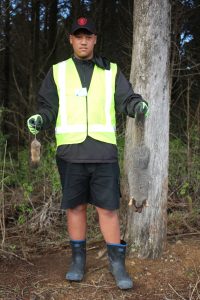
Success. Juan has just contributed to New Zealand’s Predator Free 2050 goal.
As part of the best practice learning during the two-day skills course, tutors start with the life of the pests, establishing the creatures as living, breathing animals deserving of our respect and humane treatment. Humane leg-hold traps are used to trap possums, and the students are taught how to place them and set them to cause the least discomfort to the animal while also placing them out of the reach of Kiwi.
The best way to kill a trapped possum – a club blow to a certain part of the head – is discussed and demonstrated. Students are taught not to make fun of dead possums when carrying, machine plucking or skinning them, reinforcing that they are real creatures, not playthings.
Sharing knowledge – Learning from the Tutors
Animal pest trapping isn’t fun, it’s not a game and it’s not something you do because you get a buzz out of killing things. Even money is a secondary consideration for long time trapper Pete Graham, who continues to tutor but no longer works in the industry. Our native environment and the humane treatment of the pests comes first.
“People don’t do this work because they don’t like pests. They do it because they like other things more – like native birds and animals, our native trees, and all the life our native bush sustains. Education is a very important part of helping people understand why killing pests is necessary. People need to be reassured that we treat them with respect at all times– when they’re caught in traps, when we kill them, and how we handle them after they’ve died. Once people know we work with compassion, they’re generally more able to accept the work we do.” From Tutor, Pete Graham, NRC Biosecurity Specialist.
Pete’s top possum trapping tips are:
- Use leg-hold traps on overnight trap lines for possums. Set the traps so if they catch an animal, it is kept as comfortable as possible – not in the sun, not in the rain, not left hanging
- Raise the traps to avoid catching kiwi, set the trap so that the chain allows the trapped possum to rest on the ground, and limit the time the animal is in the trap before you dispatch it. Legally, trap lines must be walked within 12 hours of sunrise
- Dispatch the animal using approved humane efforts as quickly as possible.
Aside from complying with the legalities of the business, Pete says every trapper works to a moral code based on the animal’s place as a living, breathing creature that deserves respect.
“When we kill a pest, we’re ending a creature’s life and we’re very aware of that,” Pete says. “At the same time, we’re saving lives – the lives of our native animals and birds and the survival of our native bush. This is why many of us do what we do.” Pete Graham, NRC Biosecurity Specialist.
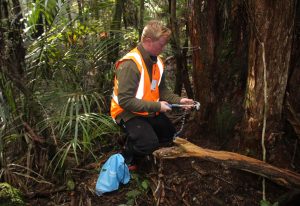
Josh dismantles the trapping station before packing up the gear and leaving the bush.
Mike Knight, NRC Kaitāia Area Officer – Biosecurity, became a seasoned possum trapper’s “shadow” as a young man and it’s a career that’s sustained him, either as a trapper or a tutor, most of his adult life.
He has some sympathy for the animals – “they didn’t ask to come here and it’s not their fault they’ve adapted so well, they’ve become pests” – but that’s about where it stops.
“They’re in the wrong place and we have to lower their numbers to get the benefits of why we live here,” Mike says. “Left alone, they’d play a huge part in ruining our native bush, plants and animals – all the things we love most about New Zealand.”
Much of Mike’s teaching work is upskilling young people in the field of pest control through the Enviroschools Programme. He works with children as young as seven, teaching them how to trap mice and explaining why it’s a good idea to do so. He tells his older students about the biology of pests, their reproduction and diet, and why hygiene in handling them is important because they are feral animals.
He teaches them about leg-hold traps and live capture trapping, how to place and set a trap in a way that’s kindest to possums and doesn’t catch kiwi, and what lures to use to maximise the chance of catching a possum at night.
The returns for possum fur entice some people into the industry. Before Covid-19, possum fur – plucked quickly from a freshly dead possum – was worth about $120 a kilo, and a possum skin was worth about $6. It’s possible to make about $100,000 a year if you’re really dedicated to the job, Mike says.
“We’re making the most out of a pest by putting a value on its fur and it’s becoming a whole new industry for New Zealand.” Mike Knight, NRC Kaitāia Area Officer, Biosecurity.
Student engagement, reflections and next steps
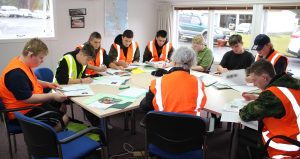
Theory is an important, though not always the most popular, aspect of gaining NCEA credits through the Northland Enviroschools Project Pest Control Programme.
Northland Project Pest Control students are overwhelmingly enthusiastic about the programme and have appreciated learning learn new skills that help our environment, contribute to their education through NCEA credits, and open-up career opportunities.
Some say they will pursue a career in possum trapping, while others intend to trap pests in their own backyards. They agree their eyes have been opened to the problem pests cause and they like knowing they can do something to help save our native trees, birds and animals.
A snapshot of the comments reported back in feedback forms is below.
“It’s good to know how to protect our native environment and I can use these skills back at home on my farm. I can trap pests around the house, but I’d better not catch Auntie’s cat!”
“I can make a positive impact by doing my bit to control possums and if we all did our bit, we could make a really big difference to our native forests. If we save them, our native animals will come back.”
“It’s good to know how to set and operate the traps humanely and correctly so the animals don’t suffer. I liked learning how to put them up at knee height, so they don’t catch kiwi.”
“I loved getting out in the bush and learning practical, hands-on skills.”
Possum skinning and plucking was a less positive experience for some, although some students really enjoyed the chance to do stuff that they’d either never done or hadn’t done for a long time.
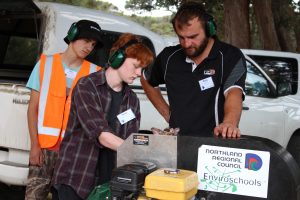
Learning how to use a possum fur plucking machine is an interesting experience for Alex and Jonas. Ricky Schraag from Can Train NZ keeps an eye on the fur removal process.
“I used to do it with my Dad, but I was a bit rusty, so it was good to refresh my skills.”
“I’ve always had an interest in possum skinning, but I’d never done it. This was my first time and I felt nervous. I thought it was a cool thing to learn and now I want to do more of it.”
Students tend to give a thumbs-down for the theory they are required to do, but a big thumbs-up for the tutors.
“They were really great. They explained things clearly and showed us what to do. They had a lot of knowledge and a lot of patience, and they taught us heaps.”
For more information about the Northland Enviroschools Project Pest Control Programme you can contact the Northland Enviroschools Regional Coordinator Susan Karels or the Enviroschools Regional Coordinator from your region through the regional contact details on this website.
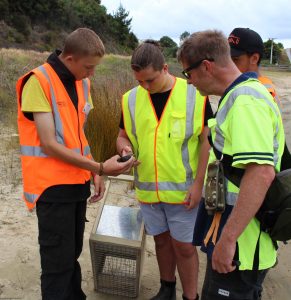
Technology is part of the pest trapping process. Biosecurity Specialist Pete Graham shows students how to use a GPS to mark trap locations.
